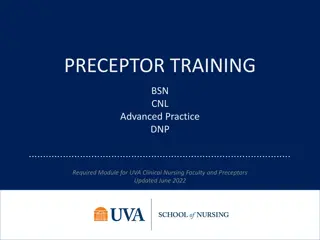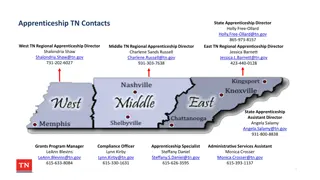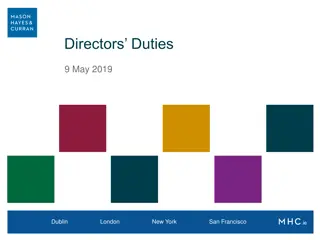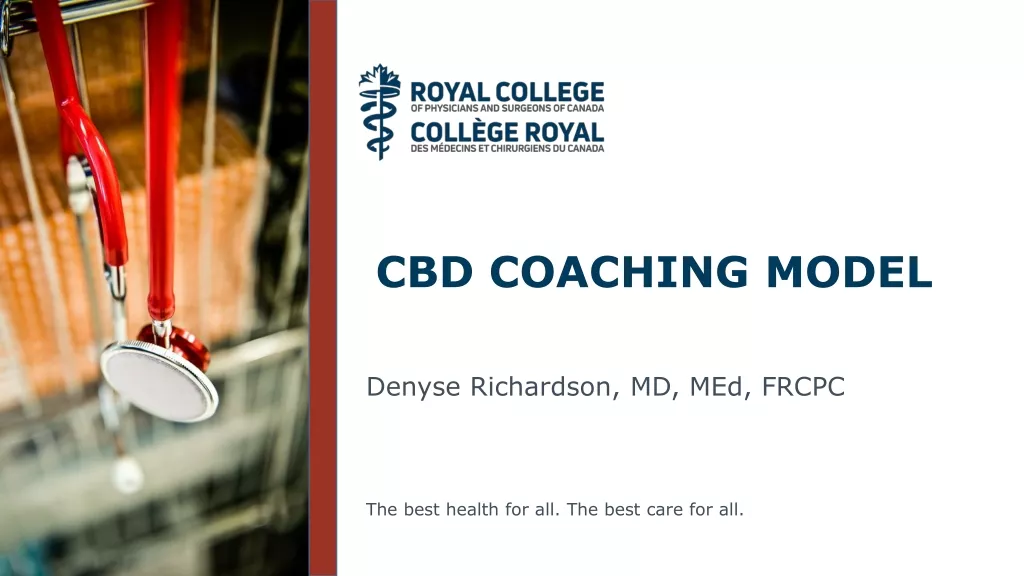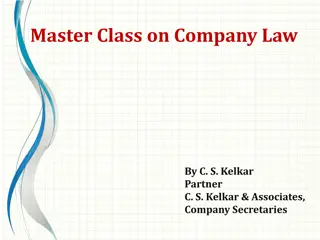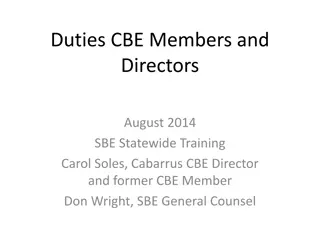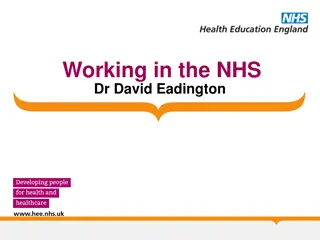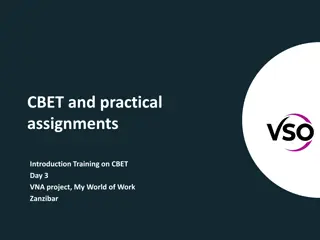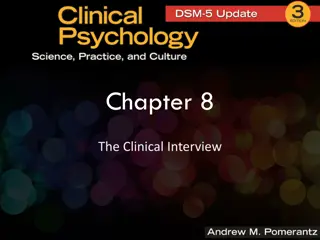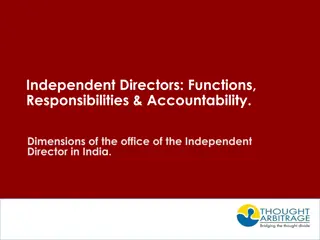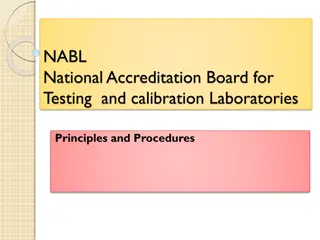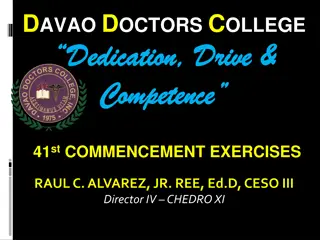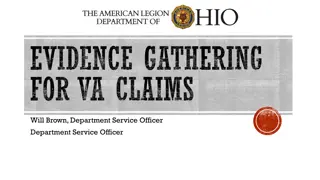The Role of Program Directors in Promoting Clinical Competence
Program directors play a crucial role in promoting clinical competence through initiatives such as competency-based medical education (CBME) and the Next Accreditation System (NAS). These frameworks aim to enhance resident education, ensure fair assessment, and facilitate efficient resource utilization. By focusing on outcomes, feedback, and individualized training, program directors can guide residents towards achieving necessary competencies effectively.
Download Presentation

Please find below an Image/Link to download the presentation.
The content on the website is provided AS IS for your information and personal use only. It may not be sold, licensed, or shared on other websites without obtaining consent from the author. Download presentation by click this link. If you encounter any issues during the download, it is possible that the publisher has removed the file from their server.
E N D
Presentation Transcript
The Role of Program Directors in Promoting Clinical Competence Lisa M Bellini, MD Vice Chair for Education Department of Medicine Perelman School of Medicine
American Society of Hematology 55th ASH Annual Meeting Disclosure Statement Lisa Bellini, MD Nothing to disclose Discussion of off-label drug use: Not applicable
Next Accreditation System National framework for assessment being developed by the ACGME. Accelerates the national focus on educational outcomes through the measurement and reporting of educational milestones, which is a natural progression of the work on the six competencies. Programs will submit composite milestone data on their residents every 6 months, synchronized with residents semiannual evaluations. Requires the formation of a Clinical Competency Committee.
Goals of the NAS Creation of a national framework for assessment that includes comparison data. Accelerate the ACGME s movement toward accreditation based on educational outcomes. Reduce the burden associated with the current structure and process-based approach. Provide opportunity for residents to learn in innovative programs. Enhance resident education in quality, patient safety, and the new competencies.
Competency Based Education and Training
What is Competency-Based Medical Education? It is an outcomes-based approach to the design, implementation, assessment and evaluation of a medical education program using an organizing framework of competencies. It requires enhanced attention to formative assessment to ensure trainees receive frequent and high-quality feedback to guide their development and the acquisition of the necessary competencies. The International CBME Collaborators, 2009
Roles of CBME Individual level: Allows focused. Individualized training. Guides remedial action. Program level: Enable fair and reliable decisions about trainee advancement. Reduces dependence on educational dwell time as a proxy for competence. National Level: CBME provides an opportunity to regain public trust by using precious resources more efficiently. Holmboe et al. Med Teacher, 2010
Clinical Competency Committee Uses predefined criteria (milestones) to make judgments more transparent. Receives input from many assessors. Incorporate narrative information in decisions. Discusses inconsistencies in assessment data. Documents assessment steps. Difficult decisions require more time, input, consultations.
Accreditation: ACGME/RRC Institution and Program Learners Program Aggregation Assessments within Program: Direct observations Audit/performance data Multi-source FB Simulation ITExam Procedure logs CCC: Judgment and Synthesis Reporting Milestones Faculty, PDs and others EPAs and Curricular Milestones
Performance is a Function of 2 Domains Skill/No Will Skill and Will Excite Delegate SKILL No Skill/ Will No Skill/No Will Direct Guide WILL
What if the CCC finds a competency deficiency?
No External Reporting Learners Feedback/Remediation Assessments within Program: Direct observations Audit/performance data Multi-source FB Simulation ITExam Procedure logs CCC: Judgment and Synthesis Non-disciplinary Disciplinary Probation/termination Requires reporting Faculty, PDs and others
Differential Diagnosis of Competency Deficiency Professionalism Communication skills Organization/efficiency/multitasking Clinical Reasoning Knowledge
Differential Diagnosis of Chronic Competency Deficiency Learning barriers ADHD Executive Dysfunction Syndrome Cultural barriers Language barriers
No External Reporting Learners Feedback/Remediation Assessments within Program: Direct observations Audit/performance data Multi-source FB Simulation ITExam Procedure logs CCC: Judgment and Synthesis Non-disciplinary Disciplinary Probation/termination Requires reporting Faculty, PDs and others
Remediation versus Probation Remediation Deficiencies primarily in fund of knowledge, clinical judgment, technical skills, suboptimal communication or professionalism Focus on coaching Improvement expected Time needed to demonstrate improvement
Remediation versus Probation Probation Problems with professional responsibilities, inappropriate communication or behavior. Immediate behavior change is needed. Use of coaches and established standards. Is a reportable action.
Remediation Requires a PLAN Put deficiencies in writing. Meet with fellow to: Assess insight Review plan Provide copy of GME policy on corrective action Obtain their signature for the above
Developing Remediation Plans Must decide if external referral if necessary to explore impact of mental health issues, presence of substance abuse, learning barriers etc. CCC must suggest strategies for remediation based on competency deficiency.
Remediation Strategies Professionalism Assigned coach Direct observation in setting where triggered Direct observation and real time feedback with patients, staff; consider SP exam Communication skills Organization/ efficiency Time motion analysis by chief fellow Direct observation Clinical Reasoning Assigned coach to break down components of clinical reasoning and practice with trainee Access to cases, online resources, reading prescription Knowledge
Remediation Strategies Change in rotation schedule Repeat rotation Repeat rotation at a different Site Increase supervision Direct observation Limit electives Lengthen the training time
No External Reporting Learners Feedback/Remediation Assessments within Program: Direct observations Audit/performance data Multi-source FB Simulation ITExam Procedure logs CCC: Judgment and Synthesis Non-disciplinary Disciplinary Probation/termination Requires reporting Faculty, PDs and others
Probation Initial attempts at remediation have not produced sufficient improvement. Disciplinary action necessary due to serious concerns of competence and/or complaints or allegation of violation of laws or regulations.
Probation Formal action that requires reporting. Probation must be described in a letter to trainee outlining: reason, length, reinstatement terms, possible outcomes . Trainee must sign for letter and receive copy of relevant GMEC policy. DIO and Legal Counsel involved.
Outcomes of Probation Successful Completion Extension of the Probationary Period Non renewal of contract Voluntary withdrawal Termination
Legal Issues Evaluation documentation Corrective and Disciplinary Action Fitness for Duty Physician Health Services
Evaluation Documentation Performance evaluations and documentation relating to corrective action serve an essential legal function. These documents should provide a clear explanation and justification for disciplinary action if the fellow appeals or brings an outside legal action. They support performance-based reason for the action.
Evaluation Documentation: Legal Implications Evaluations are confidential. Two legal categories: Evaluations are personnel records: not available to third parties upon request unless authorized by resident or ordered by court; available to resident Evaluations are peer review documents: not discoverable in court proceeding, but available to Board of Registration in Medicine upon subpoena; also available to resident
The Personnel Records Statute In most states, a personnel record is defined by law and covers a broad range of documents whether or not kept in a single file Employees are entitled to see and request a copy of their personnel record In some states, employers are required to inform employees within 10 days if information is placed in their record that is or may be used to negatively affect their status.
Retention of the Evaluations Department should maintain evaluations and other records for at least three years after resident completes or leaves the program. Department should maintain these records for a longer period if legal action is possible or resident relationship is otherwise problematic.
Legal Issues Evaluation documentation Corrective & Disciplinary Action Fitness for Duty Physician Health Services
Corrective & Disciplinary Action Not all corrective action is disciplinary . Disciplinary action has a legal definition and significance. A disciplinary action must be reported to the Board of Registration in Medicine and may trigger internal appeal rights. Non-reportable corrective actions include warnings or counseling.
Corrective & Disciplinary Action Probation is usually considered a disciplinary action that must be reported to the Board of Medicine by the Hospital. Probation typically needs to be disclosed by the trainee for future licensure, credentialing or employment application.
Trainees have Rights Fellow may appeal certain disciplinary actions: Revocation/termination Suspension Restriction, reduction, non-renewal of privileges Resident may bring legal action claiming discrimination, harassment or retaliation in response to the corrective action.
Legal Issues Evaluation documentation Corrective and Disciplinary Action Fitness for Duty Physician Health Services
Fitness for Duty Evaluations A fitness for duty evaluation is the assessment and determination of a physician s ability to practice medicine with reasonable skill and safety. Evaluations are necessary when trainees are in the formal discipline arm for mental health or physical health issues. Occupational Health typically conducts these.
State Physician Health Services Most states have Physician Health Services affiliated with their Medical Societies. Provides evaluation, support and monitoring services to physicians who are experiencing or are at risk for health related concerns. They does not provide fitness for duty evaluations Most typically used to address health-based performance concerns of physicians, including substance abuse and mental health issues
Tips for Successfully Imposing Corrective Action Seek help from the Core PD, GME and OGC. Timely feedback when issues arise. Use CCC so you are not standing alone . Documentation of evaluations, meetings with trainee and formal letters of remediation and probation are critical. Trainee needs to receive and sign for formal written notice with a copy of relevant corrective action policy. Expectations and consequences need to be clear.
Case 1 It is November and the midpoint of your 2-week rotation with a first year fellow. The fellow is very bright and has a superior fund of knowledge. On the RIME scale, he is mostly a Master. You have noticed that he has been coming in late some days and is often not prepared for rounds. Some of the nurses felt he has been curt and abrasive. You have asked several patients about him and they all uniformly say he is wonderful. You give the fellow feedback and are very clear that you expect him to be prepared for rounds and that some nurses feel he is being unprofessional. He denies that anything is going on and promises to do better. You complete your evaluation appropriately and feed some information forward to the next attending.
Differential Diagnosis of Competency Deficiency Professionalism Communication skills Organization/efficiency/multitasking Clinical Reasoning Knowledge
? acute chronic Competency Deficiency
Differential Diagnosis of Acute Behavioral Change Mental health issues Depression, anxiety, burnout Illness Substance abuse Personal relationship issues
Case 1 continued The PD meets with the fellow. She reports that 2 faculty members are concerned that he is not prepared and is seen by unprofessional. You note that this is a change as his earlier evaluations did not reveal this. He seems flat during the meeting and makes poor eye contact. He does not initially reveal any underlying issues. What now?
Framework for Conceptualizing Professionalism Behavioral domains of problems with professionalism Responsibility (i.e. unreliable attendance, problematic notification about missed activity, lack of f/u on patient care activities, late/absent, unreliable) Capacity for self-improvement (i.e. failure to accept feedback, hostile, argumentative, overconfident, overly sensitive) Relationship with patients (i.e. cannot establish rapport, lack of empathy) Relationship with healthcare team (i.e. lack of respect)
Professionalism Lapses Professionalism lapses can be further characterized in terms of timing (when in training/what types of situations), single event or repetitive, and severity. We must normalize lapses of professionalism just as we normalize concerns about other types of skills such as medical knowledge, clinical reasoning.
Approaches to Remediating Professionalism Offices of professionalism development Use of mentors Professionalism "consult team Mandated mental health evaluation Stress management/anger management classes/counseling Engage individual to help write policy (when it doesn't exist) pertinent to professionalism lapse- i.e. social media misuse->social media policy
Our Case The PD leaves the room for a few minutes and returns. Upon return she sits next to the fellow rather than across the desk. She starts by saying he is not in trouble and you would like to keep it that way but there is clearly a change in his behavior. You are concerned enough that you think he needs a EAP referral. PD gives fellow a choice of either mandatory or voluntary referral. Fellow volunteers that his wife was pregnant and lost the baby at 11 weeks. He is not coping well with the loss.




